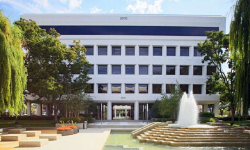- What is a Virtual Office?
- Deep Dive Into The History of the Virtual Office
- Why People Are Confused About Virtual Offices
- Interesting activity on Wikipedia’s “virtual office” entry over the years
1. What is a Virtual Office?
A virtual office is any combination of people, place, technology and process that enable individuals and entities to work more efficiently, whether remotely or in a non-centralized office.
Within this definition, the service infrastructure is often paid on an as-needed or recurring basis, as opposed to capital expenses associated with typical office infrastructures.
Virtual offices afford users the ability to add and subtract services, à la carte. This includes everything from a business mailing address to a VoIP phone system accessible by a smartphone app to a front desk receptionist. Operating as a collection of on-demand resources, a virtual office is as permanent or fluid as required by its user.
Anatomy of a Virtual Office
A major component of a virtual office is its flexibility in allowing users to rent only the services they need. Virtual office infrastructure is shared across individuals and entities allowing resources to be allocated more efficiently. A virtual office is not limited to, but can include any combination of the services listed below:
Physical Locations and Services: |
Digital or Virtual Services: |
|
|
|
|
|
|
|
|
|
|
|
|
|
|
|
Virtual Office as a term is broad. It has many characteristics and no single qualifier. It describes a style of working which encompasses a range of services and this sometimes creates confusion. While the definition above focuses on address and phone number side of virtual offices, part of your virtual office can be the Slack channel you and your team of remote workers use to collaborate, alongside the Google suite that helps you create, edit, and share files.
2. A Deep Dive Into The History of the Virtual Office
The term “virtual office” first appeared in our lexicon in the early 1980s. Let’s look at why.
In the late 1800s, the world saw an amazing proliferation of globalization, enabled by reduced tariffs and new technology (ships and trains) that allowed efficient transport of goods globally. According to The Economist, this stopped during WWI and did not really return until the 1980s as countries liberalized their trade policies, and as communications technology (in the form of computing rather than shipping) advanced further into businesses and homes.
That’s when a couple of writers,first John Markoff in 1982 and (independently without the knowledge of John Markoff’s writing) Chris Kern in 1983 began to describe the phenomenon very well. Chris’s definition of “Virtual Office” in American Airline’s in-flight magazine was:
The virtual office is a set of capabilities at remote site that are indistinguishable from those available at a real, physical office.
Now, back to the globalization trends of the 1980s.
Thanks to these advancements in communications, there are very few isolationist countries any more. Much of the globe is participating. This also makes it easier for workers to be mobile, although The Economist article points out that workers are still staying in their home countries more than expected due to certain barriers.
Not only does communication continue to get easier, but the costs of communicating are approaching zero, which enables individuals and entities to reorganize the way they work globally. Also, computing/communication devices are constantly getting smaller and more powerful.
With all of this change and advancement as a background, consider key moments that have enabled “Virtual Office Infrastructure” to exist:
- Paul Fegen started the first large chain of serviced office centers;
- VoIP technology was created by Alon Cohen (of phone.com) in 1989;
- Arpanet established the technology which was the underpinning of the internet in 1969. And Tim Berners-Lee;
- In the 1960s, Private Automated Business Exchanges (PABX) began to be used to centralize call functions. These later became known as “call centers”.
Notice how understanding such historical milestones enables us to arrive at the definition of “virtual office” that we proffered earlier:
- People: Again in the form of Paul Fegen’s shared resources, including call center receptionists, maintenance and other staff.
- Place: Paul Fegen’s shared offices.
- Technology: Tim Berners-Lee’s protocol, Arpanets packets and Alon Cohen’s audio transceiver.
Clearly these concepts have evolved drastically and are applied in many different ways, backed by heaps of interesting and innovative processes — all of which goes together to make what we know as the modern virtual office.
Virtual Office Seattle
Starting at $59.99 /mo (view all)
Safeco Plaza Building ● Downtown Seattle ● California Avenue Office Center
Virtual Office San Jose
Starting at $69 /mo (view all)
Silicon Valley Center ● Silicon Valley Business Center
3. Why Are People Confused About Virtual Offices?
- There is a serious lack of understanding of “virtual office” as a concept
- Defining each word – “virtual” and “office” – won’t adequately define the term
- Bad and Incomplete information is propagated by otherwise reputable sources
- The rise of coworking has overshadowed other aspects of virtual officing
The flexible workplace industry, and its component offerings — like the virtual office — are often perceived by those in and around the industry to be misunderstood, overlooked or worse yet, completely unknown to those who might benefit from the industry’s services.
In the past ten years, a new movement — coworking — within the flexible workspace industry has arisen and surpassed serviced offices and virtual offices in terms of popularity and buzz, and perhaps in other ways too.
Could this be due to a lack of good, clear communication of what it is, and the broad based benefits associated with having a virtual office?
Take a look at top google results for definitions of “virtual office”. While a definition on Wikipedia or some other website will not make or break an industry, if all the definitions are poor, it reveals that the originating sources of communication (those in the industry) are perhaps poor as well.
Dissecting the Term
Take our words “virtual” and “office” for example.“Virtual” is an adjective living a pretty static existence until the 20th century, when the advent of computers and software suddenly shaded the word with unpredictable implications and applications.
“Office,” having more literal than metaphorical definitions, continued to live a static existence until computing technology conspired to combine the two into a single term whose meaning is more than the sum of its parts.
Like many compound terms, its meaning cannot be understood as simply a combining of the two traditional definitions.
Virtual Doesn’t Always Mean Digital
Things are further complicated by the quaint trend of referring to anything Internet-related as “virtual,” a somewhat short-lived trend whose ghost nevertheless haunts the term “virtual office,” encouraging the simplistic notion that the term merely means “a (metaphorical? digital?) office on the Internet.”
These simplistic notions have crept into the ongoing discussion and definition of the term.
For instance, Investopedia describes a “virtual office” in such a way that it almost says nothing at all beyond an outdated, surface reading of the two terms separately:
A business location that exists only in cyberspace. A virtual office setup allows business owners and employees to work from any location by using technology such as laptop computers, cell phones and internet access. A virtual office can provide significant savings and flexibility compared to renting a traditional office space. Meetings can be conducted via teleconferencing and video conferencing, and documents can be transmitted electronically. Some companies even provide virtual office services to give virtual offices the prestige associated with physical offices, such as an important-sounding address, a professional phone-answering service and even occasional rental of office space and conference rooms.
This explanation, as meaning-free as it mostly is, is more harmful than neutral, as it just encourages an inaccurate understanding of a new thing that was born of two disparate concepts.
Also, it is full of logical fallacies…
What’s Wrong with Investopedia’s Definition?
First, there are any number of businesses, including Alliance Virtual, that can provide an address to include as part of your virtual office — not merely a “cyberspace” location, but a physical location that you can put on your business card, and where you can pick up mail or to meet with a client.
Second, we arenot really sure how to argue for or against the idea of a “location” being “cyberspace” and have decided against trying.
Not very helpful, to say the least.
Unfortunately, despite its growing reliability and accuracy, and despite its continuing reign as the most prevalent place to define terms, Wikipedia doesn’t really do any better with its two proffered definitions. In fact, one of the alleged definitions (the one for “Virtual Office”) is not so much a definition as a veiled advertisement by a company who created a cloud-based server product. We suggest this entry in Wikipedia to be removed altogether. Wikipedia recognized this entry was not useful and removed it altogether.
The entry for “virtual office” (link to a snapshot from January 28, 201[6??] is here and I will link to the snapshot rather than the actual entry due to the fact it will change, hopefully for the better after people read this post) is a little better, but still very much focused on the narrow view of a single industry and therefore limited in scope.
The Biggest Problem With The Wikipedia Entry
A virtual office provides communication and address services without providing dedicated office space.
– Wikipedia.org
This is a noble start to a definition, but like the other current web definitions of virtual office, it suffers from a significantly narrowed scope. Definitions like this are usually written by someone with special interests in a particular industry, or by someone unaware of the broader applications of the component parts of the virtual office, and how those aspects can enable people to work more efficiently. Also, it attempts to define the term by saying what it is not, which is always less than ideal.
Advertisers and Shills Hijack Entries
We could continue to parse the Wikipedia entry and find multiple flaws in every sentence, unfortunately. Most of the problems come from sloppy thinking/writing, but there is also evidence of obvious company shilling.
This is sometimes a problem for Wikipedia, given its “anyone can contribute” collaborative nature; “anyone” unfortunately includes shills and advertising specialists.
For instance, the entry contains information that has likely been planted, and which provides no real value to someone wanting to know what a virtual office is:

This is likely a marketing ploy to allow someone who is doing research (perhaps someone who is thinking of starting virtual office service company) to know there are franchise opportunities available.
In total, there are about 80 inaccuracies, logical fallacies and thinly disguised ads in the entry
Breaking Down What A Virtual Office Is
Let us not simply curse this darkness; let’s light a candle. Since Wikis are collaborative, let’s collaborate and see if we can improve upon the Wikipedia definition by developing a more genuine, transparent, balanced view of what a virtual office is:
A virtual office is any or all of a combination of people, place, technology and processes (the “Virtual Office Infrastructure”) which enable individuals and entities to work more efficiently, whether remote (at home, in Bora Bora) or in some non-centralized office . Usually, the infrastructure is paid on an as-needed and/or recurring basis as opposed to capital expenses associated with typical office infrastructures.
This definition moves us closer to a useful, inclusive, and accurate definition. A definition that includes far more aspects that most would consider part of a virtual office.
Such a revised definition is necessary because the virtual office infrastructure is shared across individuals and entities, allowing resources to be allocated more efficiently.
There are no dedicated servers, or dedicated offices or dedicated receptionists, for example. All is shared in order to make more efficient use of the infrastructure.
In theory, there is unlimited capacity and inventory, yet there is little or no excess inventory or capacity. In practicality, of course, there are limits to capacity and inventory, and there are often predictable capital expenses on the part of the provider (but not the consumer) and overhead associated with increasing usage.
Comparison: Our Definition vs Wikipedia’s
This is just one small, optional component, but it neatly illustrates why web definitions such as Wikipedia’s need some work in order to truly reflect the phenomenon that is the virtual office. To further put things in perspective, let’s lay out a list of services our definition of “virtual office” allows for, and compare and contrast these items with the current Wikipedia definition:
| Our Definition | Wikipedia Definition | |
An address to put on a business card | ||
A place to receive, pick up and/or forward mail | ||
A place to hold a meeting | ||
A place to work as needed | ||
A place to fax or make copies | ||
Someone to answer the phone | ||
A place to store electronic files | ||
An online phone system | ||
A phone number | ||
A way to bind presentations | ||
A virtual administrative assistant | ||
Instant Message / Chat | ||
Video Chat | ||
Web RTC |
As this table clearly confirms, the Wikipedia definition needs a lot of work, much of which can be facilitated by a quick look into the history and evolution of the virtual office and its place in the larger global picture.
4. Interesting Activity on Wikipedia’s “virtual office” entry over the years
This section is more of a sidebar to the foregoing information. Its intent is to help us learn from our past mistakes, and displays at worst our petulance or at best our unwillingness to recognize that many people have played many roles over decades to get us where we are today. There is no one person or moment that caused the transition to the amazingness that is the virtual office.
One of the statements in the current version of the Wikipedia entry says:
The first commercial application of a virtual office occurred in 1994, when Ralph Gregory founded “The Virtual Office, Inc” & later “Intelligent Office”, in Boulder, Colorado.[Citation is to an article in the Boulder Daily Camera, but cannot be found online] Since then & over the years, the industry has grown further with industry leaders like Davinci Virtual, Regus & Synergy [Synergy??? What?? They shuttered their doors years ago.], among others, who now offer worldwide access to offices in almost every country in the world.
If you look at previous versions of this Wikipedia entry, you’ll find a number of changes to it, with reference to Servcorp’s Alf Moufarrige pioneering the virtual office concept, to Chris Kern coining the term (but not commercializing it). Check these out here from Wikipedia in 2009, here from Wikipedia in 2011, and back to here in 2012. I also remember seeing Richard Nissen of The Virtual Office at being given a go at being the pioneer, but I had no luck finding it in the Wikipedia archives (more on this in a moment, as it looms large).
The reality is that the product that constitutes a virtual office in the serviced office industry was verifiably around before 1994. Likely, Mr. Gregory is saying that he was the first to take the term “virtual office” and apply it to a set of services others were selling.
It’s impossible to objectivelygrant him that claim, however.
It was very simple to do some research on Mr. Nissen to see that he has stated that he had the forethought to trademark “The Virtual Office” back in 1992… and lo and behold, a 30 second internet search lead us to this page.
We don’t think we can grant Mr. Gregory the first commercial application of the product called a virtual office. It probably should to Mr. Nissen, unless someone has verifiable information otherwise.
So, it is disingenuous as it is very misleading.
There is also ample proof of others in the serviced office industry selling what were commonly referred to as “business identity” plans, often coupled with the nicely descriptive phrase “everything but the office.” I consulted with Carrie Gates at Barrister Executive Suites whose predecessor company was Fegen’s Law Suites. In the image below, you can see a contract written for a client from 1992 (which as a side note, is still a client 24 years later as of this writing) for a business identity plan. Also, check out this video: (scroll down).
I don’t discount Mr. Gregory’s role in helping to popularize the virtual office. But there are those who have similarly, and likely some to a greater degree, contributed to the service offering. I would proffer that there are laureates, who are truly the founders of the virtual office. I’m talking about Tim Berners-Lee, Alon Cohen, Paul Fegen, the inventor of the PABX or automated call center (whoever that may be), etc.
Then there are the founders of the concept of communications and address services we have in our industry, originally called “business identity” then “virtual offices”: Richard Nissen, Ralph Gregory, Alf Moufarrige, Mark Dixon, Vince Otte, our own founder and CEO, Frank Cottle (perhaps I’m biased but fewmany would argue the point that he pioneered the concept of virtual office wholesaling now leveraged in various flavors by Davinci Virtual, Cloud Virtual Offices, Allied Virtual, Opus Virtual Offices, and of course, Alliance Virtual).
There are some other quite significant late comers to the game, such as Bill Grodnik at Davinci Virtual, who has done a tremendous job growing a great company that was founded in 2006. This company was built on the initial foundation of Alliance member locations and Frank Cottle’s concept of wholesaling. You can hear Mr. Grodnik talking about Alliance’s contribution to his early development on Youtube
The Public Won’t “get it” If We Can’t Define What We Do
Like all worthwhile things, creating and maintaining a relevant, profitable business model requires attention to detail and precision. This is one of the reasons why so many people seek out the services of the virtual office in the first place.
So it only makes sense to be detailed and precise about how we define what it is we do – and more than at any time in history, we collectively hold the power to influence that definition in a very real way, and to ensure its accuracy and legitimacy. The days when dubious, vague definitions could permeate the culture and thrive unchecked are gone. Collaboration changed all that, much as it spawned the virtual office itself.
Final Thoughts
We hope this sparks a meaningful discussion that helps us create a great new Wikipedia page for starters, one that mobilizes us to tell our story more clearly, articulately and coherently.
Or, as Carrie Gates said, “If we as an industry cannot clearly define what/who we are – how can we expect the general public to ‘get it’ and understand what we are?”
Exactly. We don’t want people leaving our “elevator speech” still wondering what we offer and how relevant and important it is. And we certainly don’t want them stumbling over wildly inaccurate and/or incomplete definitions on the Internet.







